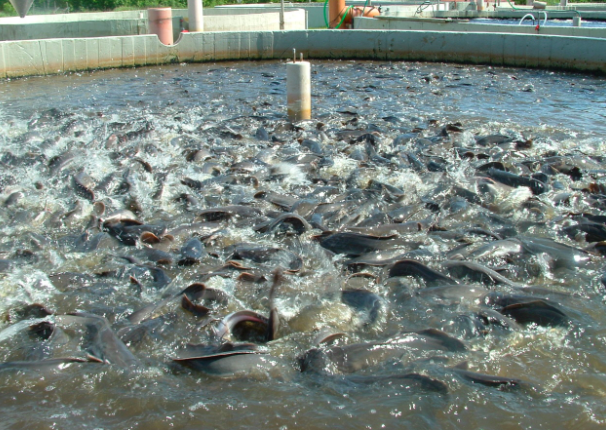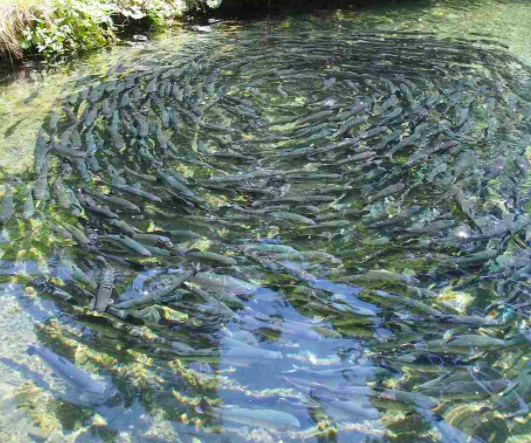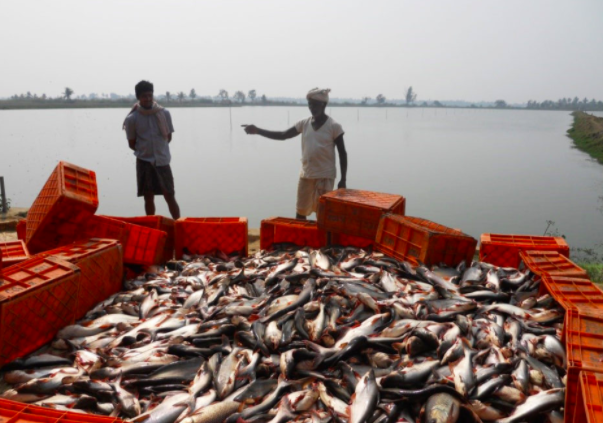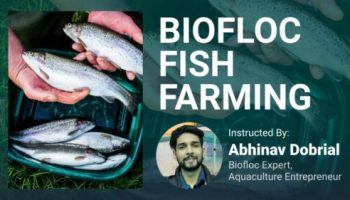Aquaculture is a major part of India’s economy and employment. India is one of the largest producers of freshwater fish in the world, accounting for more than 10% of the worldwide fish diversity. India ranks second in the world when it comes to fish production and fish farming.
Indian fisheries and aquaculture are important food production fields, providing food baskets with nutritional protection, contributing to agricultural exports, and engaging about 14 million people in various activities. Since independence, the country has shown steady and sustained increases in fish production, with diverse resources ranging from deep seas to mountain lakes and more than 10% of the global biodiversity in terms of fish and shellfish species.

How to do Fish Farming in India?
The fish farming industry of our country also has great exporting potential. Fish and fish products have currently emerged as India’s largest agricultural export group, with a quantity of 10.5 lakh tonnes and a value of 33,442 crores. This accounts for about 10% of the country’s overall exports and almost 20% of the country’s agricultural exports. In 75 countries around the world, more than 50 different types of fish and shellfish products are exported.
In 2006, the Central Government of India launched a dedicated fisheries organization under its Ministry of Agriculture. Special efforts have been made to facilitate extensive and intensive inland fish farming, modernize coastal fisheries, and enable deep-sea fishing through joint ventures. These activities have resulted in a more than four-fold increase in the production of coastal fish in FY 1950 to 3.35 million tonnes in FY 2013. Clearly, fish farming is a very important part of Indian agriculture. Not only is it so essential to our country’s economy, but it also provides many people in the states with employment and jobs.
As already discussed, fish farming has proved to be an extremely profitable business for the country and its citizens. If you as well are thinking of starting your own fish farming business, here’s a brief on all the requirements and how you can start fish farming soon!
FISH FARMING TECHNIQUES:
Your first step should be to decide which type of fish you want to farm, where you want to farm and the techniques you want to use. There are primarily 2 techniques: The cage farming system, where the farmer does not own the water body and it prevents problems like overbreeding. The second is a Land-based system, where the farmer needs to build artificial ponds or tanks, providing them with a proper water supply and farms his fish in them.
CONSTRUCTING YOUR FISH CULTURE POND: Starting fish farming in fish culture is the most common way of farming fish culture. In an enclosed area, water is stored by artificially created ponds where aquatic animals such as finfish and shellfish are reared. The ponds can be filled with canal water, rainwater, bore well water, or other water sources. But there are certain things one needs to keep in mind when building the pond, like selecting land that has a high water-holding capacity, the soil should have a neutral pH, the pond has proper inlets and outlets, it should be stated in a low-lying area, etc.

MATCHING THE GUIDELINES: In order to start a fish farm, you need to make sure that you match and follow the guidelines of the Steering Committee of Fisheries Agriculture. These guidelines are set by the Ministry of Agriculture and are the basis on which the inspections are carried out.
REGISTRATION: Your next step should be to register for a fishing license and apply for all forms. For e.g., if you wish to establish fish hatcheries, farmers will have to get approval from the Steering Committee.
KEEPING A RECORD: It is advisable for all fish farmers to keep a day-to-day record of things like the healthy growth of fish, source of seeds, farm stocking, sampling details, etc.
These are some basic steps that will help you get help in where to start. The most important step is to attain your fishing license, which has a number of requirements and steps, the details of which can easily be found online!
- FISH SPECIES IN INDIA
Though carp are the most important freshwater species in India, the majority of production is contributed by shrimp from the brackish water market. Over 90% of total Indian aquaculture production is accounted for by the three major Indian carp, namely Catla (Catla Catla), rohu Labeo (Labeo Rohita), and mrigal carp (Cirrhinus mrigala). Three exotic carp, namely, silver carp (Hypophthalmichthys molitrix), grass carp (Ctenopharyngodon Idellus), and common carp (Cyprinus carpio), were introduced into the carp polyculture system in the country during the 1970s and now form a second significant community.
The only species that has gained a lot of attention is the Philippine catfish, ‘magur’ (Clarias batrachus). Stinging catfish,’ Singhi’ (Heteropneustes fossilis) is another species of air-breathing catfish that is cultivated in swamps and derelict water bodies to some extent, especially in the eastern states. Attempts have been made in recent years to establish the culture of fish such as Pangasius pangasius, Pangasius sutchi, Oreochromis niloticus, Ompok pabda etc. Climbing perch (Anabas testudineus), murrels (Channa striata and C. marulius), etc., are other important species of finfish.
Among freshwater prawns, the most important species is the giant river prawn (Macrobrachium rosenbergii), followed by the monsoon river prawn, M.malcolmsonii. The Brackishwater aquaculture sector is primarily funded by the production of shrimp, as is the giant tiger prawn (Penaeus monodon), which is responsible for most of the production followed by the newly introduced Penaeus vannamei white leg shrimp.
In fact, within a very short span of time, the culture of this shrimp picked up on par with tiger shrimp. While India has many other potential finfish and shellfish species, its development is still of very low importance. Green mussel (Perna viridis), Indian brown mussel (Perna indica), Indian backwater oyster (Crassostrea madrasensis), Japanese pearl oyster (Pinctada fucata), and seaweed species such as Gracilaria edulis are the main farmed species in seawater.
Types of Fish Farming
- Mariculture is an activity that primarily involves the production of food for human consumption. The method of mariculture is the production of marine organisms for food, such as fish and shellfish. For example, saltwater cultivation involves finfish (such as flounder and whiting), shellfish (such as prawns and oysters), and sea plants (such as kelp and seaweed). Mariculture products such as cultured pearls and fish meals are used for cosmetic jewelry.
- Algaculture is the type of fish farming where one grows algae. This could be either microalga (like phytoplankton, microphytes, or planktonic algae) or macroalgae, also known as seaweed. Although macroalgae have a number of commercial purposes, their cultivation needs make it hard to grow and microalgae are much easier to grow on a larger scale.
- Extensive fish farming is the process that is done in a semi-natural environment, where the fish are fed natural food such as algae, zooplankton, crustaceans, etc. If the farmer wants, he can use various fish species and different techniques to alter and change the environment of the pond.

- If the farmer wishes to increase the production of the pond, he can use fertilizers such as animal wastes. In order to maintain the natural balance within the system, the farmer stocks the pond with a number of fish species, that serve different purposes and feed on different things, hence playing different roles in the system. The farmer needs to keep in mind not to overfeed or over-fertilize the pond since this could lead to overgrowth of algae and eventually lead to losses of more fish. Usually, the fishes farmed using this method are tilapia, catfish, and carp.
- Ranching is a subset of extensive farming wherein the fish, although raised in confinement, are released into the wild to feed and recaptured when they have reached the desired size. Salmon is one type of fish that is reared using this method.
- Intensive fish farming is what is done in closed tanks or flow-through raceways or cages floating in the sea, open to the natural environment. In this method, the oxygen, food supply, and water quality are maintained together, while these tanks are provided with good water purification systems. Although the rate of production in this fish farming is high, the cost of maintenance is also expensive. The fishes are more prone to catching diseases and skilled, practiced, and professional expertise is required to uphold and look after these tanks. The fishes that are usually farmed with this method are salmon, sea bass, tuna, sturgeon, etc.
- Intensive fish farming can also be divided into more methods such as integrated recycling system, semi-closed system, floating cage system, and semi-intensive fish farming.
How to farm fish better?
Here are some steps that can help you expand your fish farm, make your business even more commercial and make the fishes you produce better!
- Investing in progress in technology and transition. Aquaculture, decades behind that of animal farming, is a young business. Improvements in breeding technology, disease control, feeds and nutrition, and low-impact production systems are interlinked fields where research can supplement conventional expertise to improve performance. In every part of the world, these types of technologies have been behind productivity increases, whether driven by producers, research organizations, corporations, or governments.
- Beyond the farm, emphasis. Most aquaculture regulations and qualification schemes are centralized at the level of the individual farm. But, even if everybody follows the rule, having several producers in the same region can lead to cumulative environmental effects, such as water contamination or fish diseases. Spatial planning and zoning can ensure that aquaculture activities remain within the carrying capacity of the local ecosystem and can also reduce resource use conflicts.
- Eat fish that is low in the food chain. If farmed fish don’t need large quantities of wild fish in their diets, fish farming will relieve pressure on marine habitats. Consumers should also demand “low-trophic” species such as tilapia, catfish, carp, and bivalve mollusks that feed poorly on the food chain. The focus should be put on these species in emerging economies, where consumption of low-trophic species is still dominant, even as billions of people join the global middle class in the coming decades. At the same time given that fish are a major source of nutrition for more than a billion poor people in the developing world, it will be important to expand aquaculture to meet the food and nutritional needs of these consumers.
- Shift rewards for sustainability reward. Farmers can be given incentives to practice more sustainable aquaculture through a variety of public and private policies.
Clearly, fish farming is a very important part of the Indian economy and extremely essential to the food production and employment conditions of our country. Over the years, fish farming has proved to be one of the most successful businesses to venture in and every person can make it big!



One Response
I need a job im a stdent of fisheries.